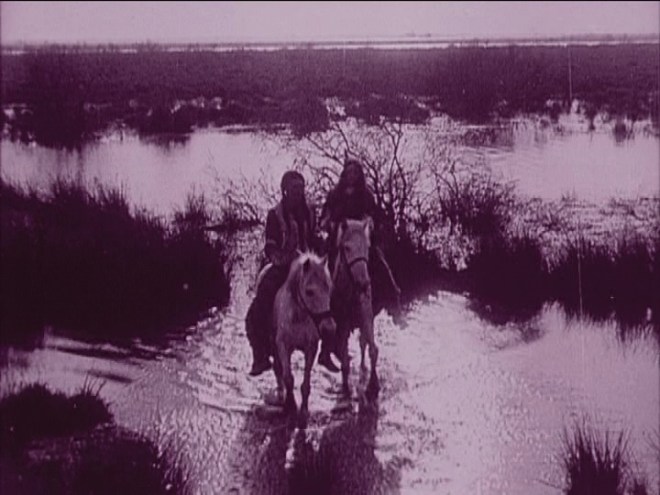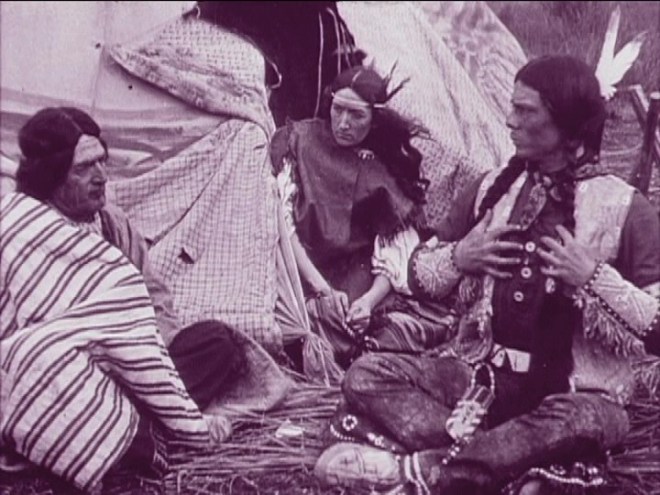One of the western pictures director Jean Durand and his madcap team made in Camargue, France, this tells the story of a poor suitor trying to win the love of a chief’s daughter. The solution: grand theft.
Home Media Availability: Released on DVD.
Steer Rustling French-Style
There are few things I enjoy more than European westerns. Seeing familiar tropes translated through Continental eyes is always interesting and the way shopworn plots are shaken up is exhilarating. Plus, American films have done their share of European stories over the years so turnabout is fair play.

Wild west shows were far more responsible for shaping these tropes than the actual wild west and European audiences were just as enthralled with them as their American counterparts. Lest you think the foreign shows were less elaborate than the ones put on in the States, premiere showman Buffalo Bill Cody’s entourage during a jaunt to London included “97 Indians, 180 horses, 18 buffalo, 10 elk, 5 Texan steers, 4 donkeys, and 2 deer.”
Such spectacle fired the imaginations of European audiences just when motion pictures were starting to emerge as an exciting new art and one of the first European western film stars was Parisian Joë Hamman. Hamman had seen wild west shows during a trip to America and enthusiastically embraced all the skills of a cowboy showman, from stunt riding to roping to leaping onto moving trains.

Hamman and director Jean Durand, best remembered today for his anarchic Onésime comedy series, made westerns in the Camargue marshlands and they are really something. The Railway of Death, in which Hamman duels for a mining claim, are best described as Coyote v. Roadrunner cartoons with real guns. Dark, bloody, anarchistic and riotous, they are a revelation for any viewer of spaghetti westerns. Yes, Europeans were doing that kind of thing a half-century before Clint Eastwood donned a poncho.
Burning Heart replaces the cowboys with Native Americans (with, alas, an entirely French cast playing them) and tells the story of forbidden love, grand theft and humans being hunted for sport. So, basically, par for the Camargue western course.

Hamman plays Burning Heart, a young man hoping to marry Sunbeam (Berthe Dagmar), the daughter of the chief. (Though I believe the character’s French name, Mouche-de-Feu, translates to “Firefly” so I am not sure if “Sunbeam” is based on an original English translation or something more modern.) However, Sunbeam’s father refuses to allow his daughter to marry a man without a herd of cattle to call his own.
This is clearly a problem but Burning Heart and Sunbeam have an easy solution: they will steal the livestock of a neighboring tribe and remove any objections to their union. And so, the pair ride off together and Bonnie and Clyde that herd right out from under their lawful owners. Unfortunately, the theft does not go unnoticed for long and the victims of the theft vow revenge.

Will Burning Heart and Sunbeam finally be able to tie the knot? Or will they be made to pay for their crime?
Joë Hamman is showcased to advantage here. He doesn’t make use of his famous roping tricks but he does engage in fisticuffs, hard riding and cold-blooded ambushes. (Despite his boyish looks, Hamman’s characters had a high body count even compared to bloodthirsty American cowboys like William S. Hart.)

As always, I am impressed and delighted by Berthe Dagmar, the resident leading lady of the Durand troupe who trained animals and performed her own stunts. (Jean Durand knew what was what, he later married her.) Sunbeam is a proactive, ride or die heroine who helps her man rustle cattle and later rides to his rescue when he’s in a pickle. This was reasonably common in 1910s films, which often featured women in action star roles, but Dagmar’s obvious athleticism makes her heroism even more convincing.
(If you want to see Dagmar at the height of her abilities, check out Under the Claw, in which she is leapt upon by a trained leopard and wrestles with it.)

The Camargue setting is used thoroughly in this picture as well, with characters stomping and splashing through the salt marshes and swimming in saltwater. It’s practically a tourism advertisement.
As for a sense of North American place, well, European westerns always have certain little details that reveal them as not being made in the U.S.A. (a patterned fabric here, a building shape there) but that’s part of the fun and the charm of them. The time and exact location are unclear but the use of tipis would lead one to assume it is meant to take place on the Great Plains and the European-style shirts with cuffs and buttons as well as the repeating rifles would mark the time period as the mid-1800s or later. (Obviously, I am taking for granted that little to no authentic culture was incorporated into the story.)

In any case, the Durand/Hamman westerns were about thrills and this one delivers. When Burning Heart is being hunted down by his enemies and manages to evade them thanks to some equestrian aquatics, I was cheering for him the whole time. In my opinion, that’s the main goal of an adventure picture, so well done there. This is the kind of zippy filmmaking that was so much in demand during the early 1910s and it’s easy to see why. Maximum thrills economically presented by a talented cast and crew.

While not quite as deranged as The Railway of Death, Burning Heart still showcases the madcap sensibilities of Durand’s team, the stunt prowess of Hamman and Dagmar and the impressive production values of Camargue westerns. I thoroughly enjoyed myself and I hope that more of these splendid films become available.
Where can I see it?
Released on DVD by Kino as part of the Gaumont Treasures Vol. 2 box set, which also includes films from Emile Cohl and Jacques Feyder. The film is accompanied by an excellent score composed by Patrick Laviosa and performed by a small ensemble.
☙❦❧
Like what you’re reading? Please consider sponsoring me on Patreon. All patrons will get early previews of upcoming features, exclusive polls and other goodies.
Disclosure: Some links included in this post may be affiliate links to products sold by Amazon and as an Amazon Associate I earn from qualifying purchases.

This looks really exciting, thank you for posting this.
Thank you!